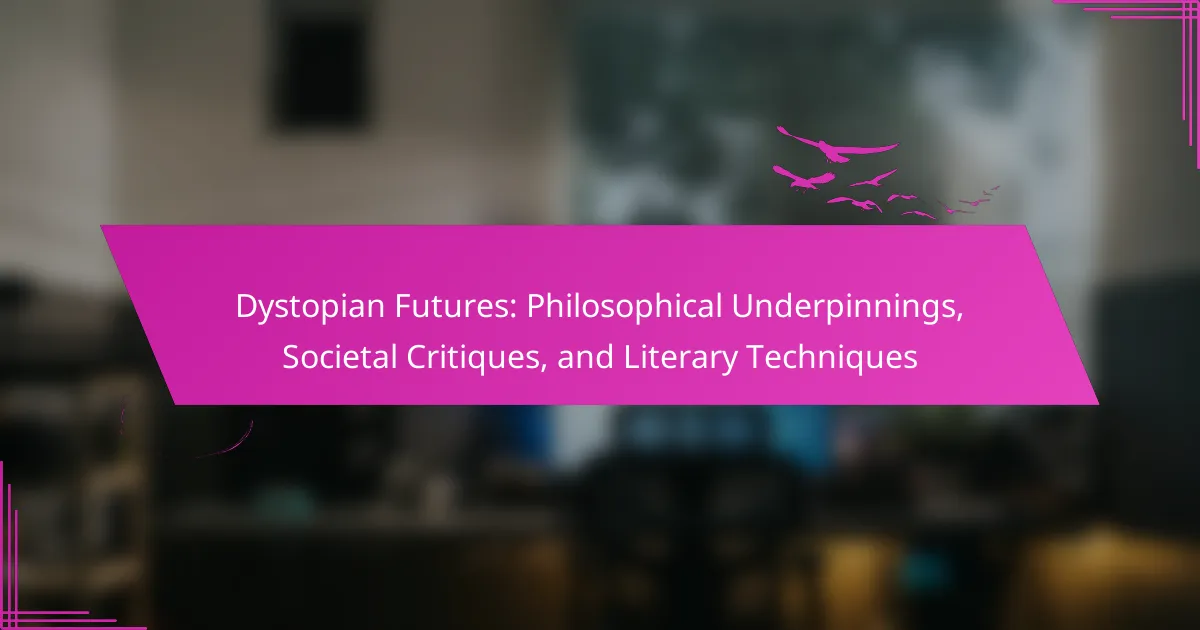Dystopian futures challenge our understanding of society and human behavior. This article examines the philosophical foundations that critique societal norms, explores the societal implications of these narratives, and analyzes literary techniques that enhance their critiques. Key works like Orwell’s “1984” and Huxley’s “Brave New World” serve as primary examples, revealing the dangers of unchecked power and technological advancements. By reflecting on these themes, we can better understand the potential trajectory of civilization.

What are the philosophical foundations of dystopian futures?
Dystopian futures often stem from philosophical foundations that critique societal norms and human behavior. Central themes include existentialism, which questions the meaning of life in oppressive systems, and utilitarianism, which explores the morality of sacrificing individual rights for the greater good.
These philosophical underpinnings reveal the consequences of unchecked power and technological advancements. For example, works like George Orwell’s “1984” illustrate surveillance and loss of autonomy, while Aldous Huxley’s “Brave New World” critiques consumerism and conformity.
Literary techniques such as allegory and irony enhance these critiques, allowing authors to convey complex ideas about freedom, identity, and morality. The exploration of these themes serves as a warning against potential futures shaped by current societal trends.
Ultimately, the philosophical foundations of dystopian futures prompt reflection on our values and the trajectory of civilization.
How do dystopian narratives reflect societal anxieties?
Dystopian narratives reflect societal anxieties by illustrating fears about authority, technology, and environmental collapse. These stories often critique current social dynamics, warning against unchecked power and loss of individual freedoms. For instance, George Orwell’s “1984” mirrors concerns about surveillance and totalitarianism, while Margaret Atwood’s “The Handmaid’s Tale” addresses gender oppression and reproductive rights. Through exaggerated scenarios, these narratives provoke critical reflection on contemporary issues, encouraging readers to consider the consequences of societal choices. The unique attribute of dystopian literature lies in its ability to transform real-world anxieties into cautionary tales, fostering awareness and dialogue.
Which philosophical theories are commonly explored in dystopian literature?
Dystopian literature often explores philosophical theories such as utilitarianism, existentialism, and social contract theory. These theories critique societal structures and human nature, reflecting on morality and the implications of oppressive regimes. For example, utilitarianism questions the morality of sacrificing individual rights for the greater good. Existentialism emphasizes individual freedom and choice amidst oppressive circumstances. Social contract theory examines the legitimacy of authority and the relationship between individuals and the state. These philosophical underpinnings deepen the narrative and provoke thought on contemporary societal issues.
What role does ethics play in shaping dystopian worlds?
Ethics play a crucial role in shaping dystopian worlds by highlighting moral dilemmas and societal consequences. In literature, ethical considerations often expose the flaws in governance, technology, and human behavior. These narratives serve as critiques of real-world issues, prompting readers to reflect on their values. For instance, the portrayal of surveillance in dystopian stories raises questions about privacy and autonomy. Such ethical explorations encourage critical thinking about the future and the choices that lead to dystopian outcomes.
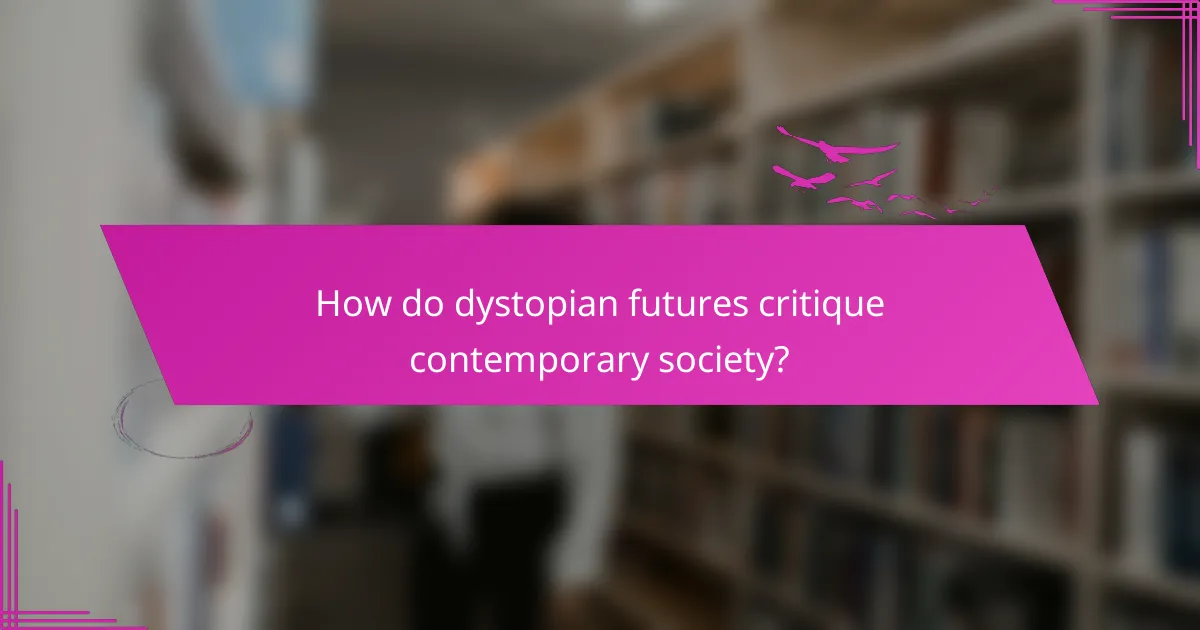
How do dystopian futures critique contemporary society?
Dystopian futures critique contemporary society by highlighting flaws and warning against potential consequences. These narratives often reflect social, political, and technological issues. They use exaggeration to emphasize current trends, revealing the dangers of authoritarianism, environmental neglect, and social inequality. For example, George Orwell’s “1984” critiques surveillance and loss of individuality, while Margaret Atwood’s “The Handmaid’s Tale” explores themes of gender oppression and reproductive rights. Such works encourage readers to reflect on their realities and consider the implications of their choices.
What societal issues are highlighted in dystopian narratives?
Dystopian narratives highlight societal issues such as totalitarianism, environmental degradation, and social inequality. These stories serve as critiques of contemporary political and social trends, revealing the potential consequences of unchecked power and technological advancement. They often explore themes of surveillance, loss of individuality, and the impact of capitalism on human relationships. By exaggerating these issues, dystopian literature prompts readers to reflect on real-world challenges and their implications for the future.
How do different cultures interpret dystopian themes?
Different cultures interpret dystopian themes through their unique historical, social, and political lenses. For example, in Western literature, dystopias often reflect fears of totalitarianism and technological control, as seen in works like George Orwell’s “1984.” In contrast, many Asian narratives may explore themes of environmental degradation and societal collapse, reflecting regional concerns about rapid industrialization.
Cultural background influences the portrayal of authority and rebellion. In Latin American literature, dystopian narratives frequently critique social inequality and corruption, drawing on historical experiences of oppression. African dystopian stories often incorporate post-colonial themes, emphasizing resilience and community in the face of systemic challenges.
These interpretations shape how audiences connect with the underlying philosophical questions of freedom, identity, and morality within dystopian futures. Each culture’s unique attributes enrich the genre, providing diverse perspectives on the human condition.
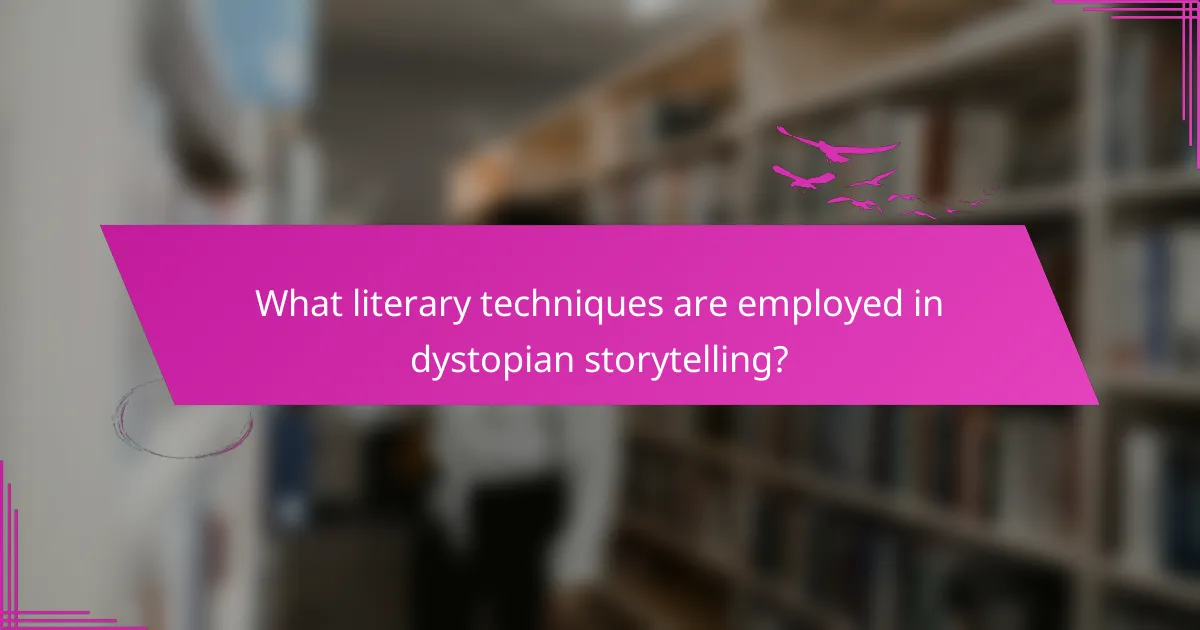
What literary techniques are employed in dystopian storytelling?
Dystopian storytelling employs techniques such as satire, symbolism, and foreshadowing to critique societal norms. Satire highlights flaws in government or culture, while symbolism conveys deeper meanings through objects or characters. Foreshadowing creates suspense and emphasizes the consequences of societal issues. These techniques enhance the narrative’s philosophical underpinnings and societal critiques, making the themes more impactful.
How does world-building enhance the narrative of dystopian fiction?
World-building significantly enhances the narrative of dystopian fiction by creating immersive settings that reflect societal critiques and philosophical themes. These constructed realities often serve as a backdrop for exploring human behavior under extreme conditions, revealing moral dilemmas and ethical questions. By elaborating on unique attributes of the world, such as oppressive governments or environmental collapse, authors can deepen the emotional impact and relevance of their stories. This technique allows readers to engage with complex ideas, fostering a critical examination of contemporary issues through the lens of speculative futures.
What narrative structures are typical in dystopian literature?
Dystopian literature typically employs structures that highlight societal decay and moral dilemmas. Common narrative techniques include first-person perspectives, unreliable narrators, and fragmented timelines. These elements create a sense of disorientation and reflect the chaotic nature of dystopian societies. Additionally, contrasting utopian ideals with grim realities serves as a critique of contemporary issues.
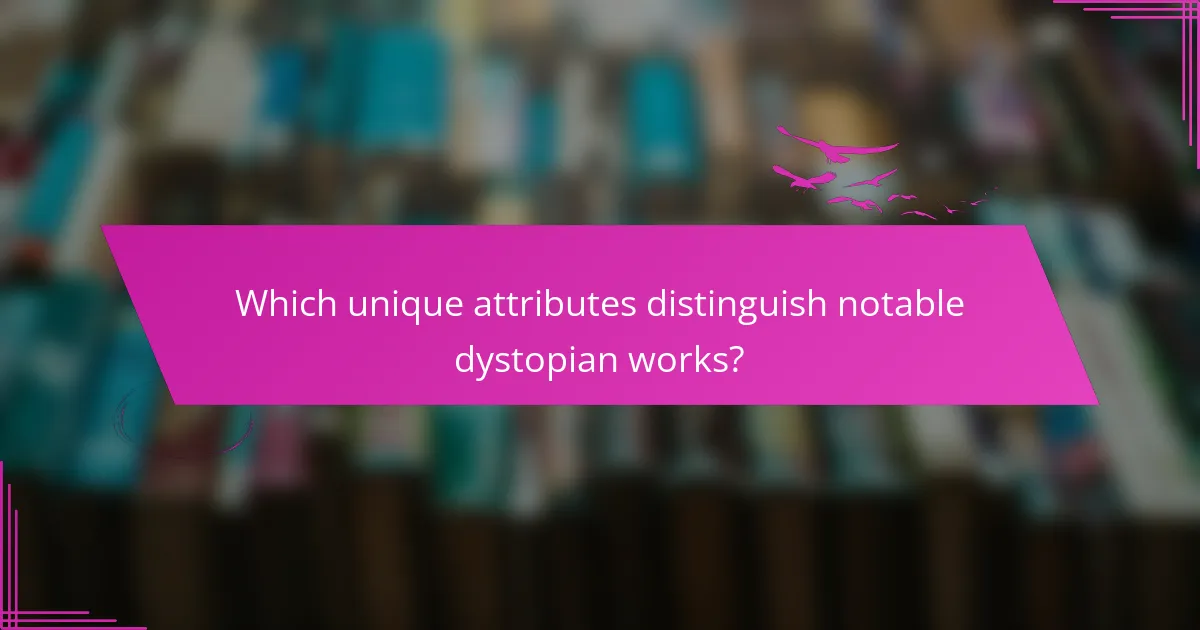
Which unique attributes distinguish notable dystopian works?
Notable dystopian works are distinguished by their exploration of unique attributes such as societal control, the loss of individuality, and the use of oppressive technologies. These attributes provoke critical reflections on contemporary issues. For instance, George Orwell’s “1984” emphasizes surveillance, while Aldous Huxley’s “Brave New World” critiques consumerism. Each work employs distinct literary techniques to convey its themes, enhancing the reader’s understanding of the underlying philosophical questions.
What makes specific dystopian novels stand out in literary history?
Specific dystopian novels stand out due to their profound societal critiques and innovative literary techniques. These works often explore philosophical themes like totalitarianism, surveillance, and human nature. For example, George Orwell’s “1984” employs a unique narrative style that immerses readers in a bleak, oppressive world, highlighting the dangers of authoritarianism. Similarly, Aldous Huxley’s “Brave New World” presents a rare attribute by showcasing a society that sacrifices individuality for stability, prompting critical reflection on consumerism and technology. These novels remain relevant as they provoke thought on contemporary issues, ensuring their place in literary history.
How do character archetypes influence the themes of dystopian stories?
Character archetypes significantly shape the themes of dystopian stories by embodying societal fears and critiques. Common archetypes, such as the rebel, the tyrant, and the savior, illustrate conflicts between individuality and conformity. These characters often represent root attributes of power dynamics and resistance within oppressive systems. Unique attributes, like a character’s moral ambiguity or transformative journey, deepen the narrative’s exploration of human nature and societal flaws. Additionally, rare archetypes, such as the reluctant hero, can challenge traditional narratives, prompting readers to question their assumptions about morality and justice in dystopian settings.
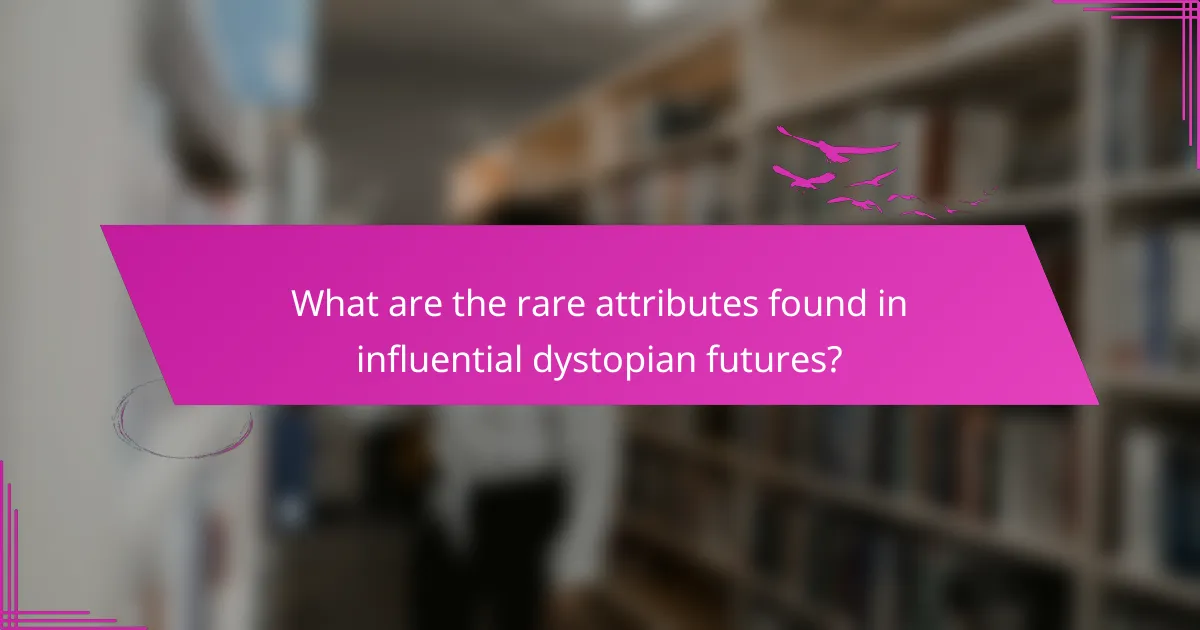
What are the rare attributes found in influential dystopian futures?
Influential dystopian futures often feature rare attributes that enhance their narratives. These attributes include extreme surveillance systems that create a pervasive sense of paranoia, unique government control methods that manipulate reality, and rare technological advancements that fundamentally alter human interaction. Additionally, some works explore the psychological impacts of isolation in societies, showcasing characters with profound existential crises. These elements serve to critique contemporary societal issues while provoking philosophical reflections on humanity’s trajectory.
Which lesser-known dystopian works offer unique perspectives?
Lesser-known dystopian works like “The Dispossessed” by Ursula K. Le Guin and “Fahrenheit 451” by Ray Bradbury provide unique perspectives on societal structures. “The Dispossessed” explores anarchism and capitalism’s contrasts, while “Fahrenheit 451” critiques censorship and conformity. Other notable titles include “Parable of the Sower” by Octavia Butler, which addresses climate change and societal collapse, and “The Windup Girl” by Paolo Bacigalupi, which delves into biotechnology and resource scarcity. These narratives challenge conventional dystopian themes, offering fresh insights into human nature and societal dynamics.
How do experimental narrative styles shape reader engagement in dystopian fiction?
Experimental narrative styles significantly enhance reader engagement in dystopian fiction by creating immersive experiences. These styles often employ fragmented timelines, unreliable narrators, and multiple perspectives, which reflect the chaotic nature of dystopian societies. As a result, readers become more invested in the characters’ struggles and the philosophical questions posed by the narrative. Unique attributes of these styles, such as nonlinear storytelling, challenge conventional reading patterns, prompting deeper reflection on societal critiques. This engagement fosters a more profound emotional connection, allowing readers to confront the moral implications of the depicted futures.
What lessons can be learned from dystopian futures?
Dystopian futures teach critical lessons about societal structures and human behavior. They highlight the consequences of authoritarianism, technological overreach, and environmental neglect. These narratives often serve as warnings, urging vigilance against complacency. For instance, George Orwell’s “1984” illustrates the dangers of surveillance and loss of personal freedom. Similarly, Margaret Atwood’s “The Handmaid’s Tale” critiques gender oppression and the erosion of rights. Such works encourage reflection on current societal trends, prompting discussions on ethics and governance. Ultimately, they emphasize the importance of individual agency in shaping a just future.
What are best practices for analyzing dystopian literature?
To analyze dystopian literature effectively, focus on thematic exploration, character development, and narrative structure. Examine how these elements reflect societal critiques and philosophical underpinnings.
1. Identify key themes such as surveillance, oppression, and environmental collapse.
2. Analyze character motivations and their roles in illustrating societal flaws.
3. Evaluate narrative techniques like unreliable narrators and non-linear timelines.
4. Consider historical context and its influence on the dystopian vision presented.
This approach enhances understanding of the genre’s critiques and relevance.
